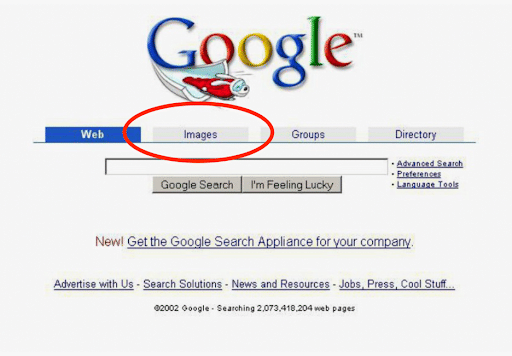1. The Early Years
Do you recall the logo? It was one of the early search engine logos (note how it used the same exclamation as the well-known Yahoo! logo). Google Search was a wonderful tool for discovering information on practically any topic you could think of during those early years, from 1998 to 2000. However, due to its immaturity, the search engine was not always successful in providing the best results.2. The Middle Ages
Google got a new logo at the end of the twentieth century and was set to enter the new millennium. They would keep this logo until 2010 when the company was beginning to gain recognition.From 1999 through 2010, the search engine went through several incarnations of its Search Engine Results Pages (SERPs), including the introduction of its AdWords program in 2000:

In 2001, Google Images, or Image Search, was launched:

Before the end of the first decade of the 2000s, there was a slew of new features, including video, mobile search, local search, and maps.
3. The Next Decade-
As we approached the years 2010 to 2020, the history of Google Search is best remembered at a breakneck pace - that is, many changes occurred, including:Authorship - Authorship tags could be used by content writers to boost their visibility in search results. Since then, the search engine has stopped using authorship.
Google+ — The search engine's first (and so far only) foray into social media, Google+ allowed businesses to create profiles and share information about their enterprises, events, and updates.
Hummingbird — Widely regarded as the most important improvement to Google since its inception, Hummingbird used machine learning and conversational search to determine a user's search intent.
Putting the customer first — For the first time ever, smartphone searches outnumbered desktop searches. Google reacted in kind, urging mobile-first web design to keep up with the expanding trend.
Search advertising was moved from the right sidebar to the top of search results around this time, ushering in a new ad type known as Expanded Text Ads.
People Also Ask – Featured Snippets These new "answer boxes" appeared at the top of SERPs to provide users with quick answers to frequently asked questions.
4. Today-
While the Google logo has been the same since 2015, the SERPs have undergone several changes since 2020. The following are the most notable:- MUM – The Google MUM update uses artificial intelligence (AI) to better analyze various sorts of content — such as photographs, video, and audio — and provide more accurate search results. It also emphasizes content in several languages, as well as conversational search at the next level.
- Users' Search Intent - Over the last few years, and particularly during the height of the pandemic, users' search intent has shifted considerably. Google made a change to its SERPs in response.
- SERP Format Changes - Over the course of Google Search's existence, the SERPs have evolved significantly, with today's search results providing a variety of formats of information to satisfy user intent.



